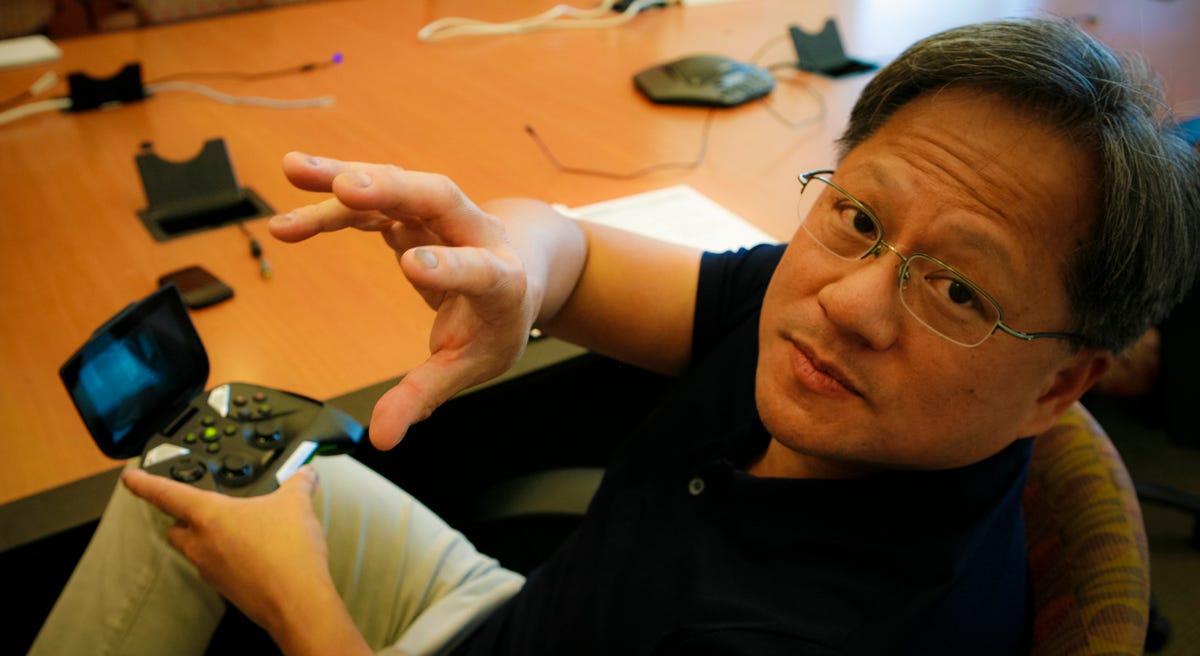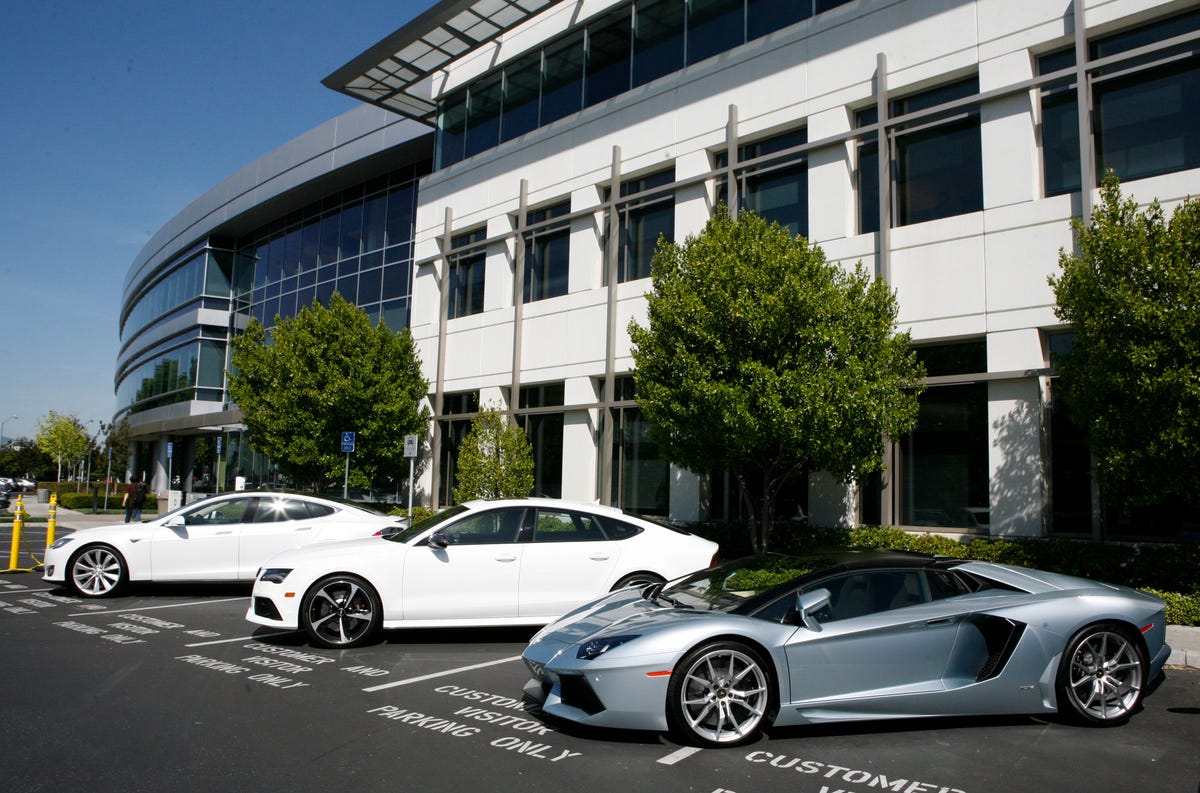
Shara Tibken/CNET
SANTA CLARA, Calif. — Nvidia is shifting gears again.
The company, which has risen to prominence by creating graphic processing units, or GPUs, for computers, has long been looking for other avenues of growth. It had sought to break into the smartphone and tablet business, but has largely been shut out, and is now looking at gaming devices and cars as its next big opportunity.
Whatever the area, Nvidia needs to capitalize on it fast. Last year, PC shipments posted their worst-ever drop of 10 percent, according to Gartner. And the tech research firm expects shipments to drop more than 6 percent this year and fall again next year.
Even as most smartphones passed on Nvidia’s Tegra chip, it found its way into notable products like the Xiaomi Mi Pad tablet and the first two versions of Microsoft’s Windows RT-powered Surface tablet . But the latest reports suggest Qualcomm will supply the chip for Microsoft’s new smaller-screen Surface instead of Nvidia.
Nvidia CEO Jen-Hsun Huang didn’t want to talk about Surface with CNET as much as the company’s new strategy, which he believes will pay off for the chipmaker. The following is an edited transcript of our conversation, which took place Wednesday here at the company’s headquarters.
Q: Some reports say Nvidia isn’t targeting smartphones and tablets with Tegra anymore. Has your strategy shifted?
See also
- CNET’s take on Nvidia Shield
- PCs sales may suck, but people still are buying Nvidia GPUs
- Nvidia’s CEO talks Shield with CNET: Yes, there will be future models
- Microsoft Surface event: Join us Tuesday, May 20 at 8 a.m. PT (live blog)
Jen-Hsun Huang: The strategy has shifted, but that’s not quite right. The reason for that is this: First of all, we see that mobile is not about phones only. One of the most important mobile devices is a phone, but mobile technology is revolutionizing [products] all over the place…It’s going to revolutionize TVs. It’s going to revolutionize, obviously, computers. But it’s also going to revolutionize games and cars and all kinds of stuff. Our strategy is to go and focus our energy on segments of mobile where we can add the most value. The area where we can add the most value is visual computing, graphics, GPUs, etc.
In some phones, visual computing is important, but in a lot of phones, visual computing is just not that important. So what we wanted to do was focus on No. 1. gaming, where we can add a lot of value, and we think gaming on Android is going to be important. We’re going to focus on car computers where visual computing and supercomputing technology is really important to the future of cars. And then we’re going to focus our energy on segments of mobile computing, segments of phones and tablets where computer graphics are really important.
Are those gaming-specific devices, or what do you mean?
Huang: A gaming-specific device certainly is one example. [Also] set-top boxes that are designed for gaming, tablets where they would like to highlight gaming. Tablets where instead of just highlighting the design, they’d also like to highlight the performance.
That goes hand in hand with gaming processors as performance. If you want to build the Porsche of tablets or phones, we’re a fabulous partner for that. That’s why companies like Xiaomi like working with us. They’re reaching out to a technology-forward fan base.
Does that mean we’re not going to see Nvidia in smartphones? You earlier said gaining share in smartphones was a matter of releasing a processor, called Tegra 4i, that integrated 4G with your apps processor. Has that not worked?
Huang: [Tegra 4i] wasn’t that successful for us. I would say that when we first started this, we thought that bringing 4G to entry-level phones, mainstream phones, integrated with our apps processor would be a real opportunity. I think that the phone marketplace has commoditized really, really fast. It is not our strategy to go after commodity phones. It is not our strategy to go after mainstream devices. But our strategy is to focus on performance-oriented, visual computing-oriented, gaming-oriented devices where we can add a lot of value.


Shara Tibken/CNET
Of course, if I said these things three years ago, it would have sounded really strange. And the reason for that is because cars weren’t really prevalent with computers inside and it wasn’t a very large part of our strategy or a large part of our business. Now it’s growing significantly; it’s a large part of our business now. And you’re seeing more and more Android compute devices, whether it’s game consoles or gaming devices in China from Huawei or ZTE. You’re seeing devices that are highlighting their gaming and performance capabilities much more.
People are recognizing [that in] the Google Play store, the No. 1 download is games. Now all of a sudden, there’s a lot more discussion about Android as a platform for gaming…Just three years ago if I said these things, all people wanted to focus on was phones. Now we have a lot more pillars of growth in mobile, and we’re just not going to go focus on mainstream phones.
Why did Tegra struggle in smartphones?
Huang: Our focus as a company is still performance-oriented. The mainstream phone market commoditized so fast that really the…differentiators were price. And you can see the pressure that MediaTek is putting on Qualcomm, and you can see the pressure that MediaTek is putting on Marvell and Broadcom and all of these companies. Because guess what? They’re the lowest-cost provider. I think that for mainstream phones, there’s one strategy that really works right now, which is price. That’s not our differentiator. That’s not what we do for a living.
Will there be a Tegra 5i or whatever you would call a chip that integrates 4G with an apps processor?
Huang: We don’t talk about future products, but I also haven’t talked about T5i.
You delayed Tegra 4 for Tegra 4i. Did that turn out to be a mistake? Did you miss this whole design cycle?
Huang: I would say that Tegra 4i didn’t pan out. We learned a lot in the process. But there are many things in our company that didn’t pan out. That’s OK. If you want to be an innovative company, you have to fail.
Look, we built a great chip. LG’s shipping it in the rest of the world outside the United States. It’s a fantastic processor. But from a business strategy, it wasn’t a success. So I learned a lot from it. It’s OK. I’m glad I did it, and now we’re moving on.
Nvidia Shield






+8 more
So what did you learn?
Huang: I think that I learned we are not a commodity player. Going after something that starts with mainstream should have discouraged us. At the time, it looked like our 4G solution was quite far ahead of the market…But that window’s closing very quickly. We’re just not a cost player.
What’s going on with Microsoft’s Surface? Are you still supplying chips for the tablet?
Huang: No comment…But I’m guessing…Surface does mean more than one thing. For example, we weren’t in Surface Pro; that was Intel. We weren’t in small phones; that was Qualcomm. We were in a particular device. There’s going to be a whole lot of Surface devices is my guess. We’ll try to win what we can.
In terms of gaming, Nvidia launched its Shield device last year. When you announced it, you told CNET that you were already working on future versions of Shield. Are you still working on new models? When will we see them?
Related links
- CNET’s take on the Surface 2
- PC shipments to sink 6 percent this year as tablets surge — Gartner
- 3DS, Vita, Shield, phone, tablet: Which game handheld should you buy?
Huang: Yeah, there are plans [for more Shield devices]. The way to say it is, obviously we have all kinds of exciting things we like to show. But at the core…of this strategy, Shield is the platform that we will use to transform Android into a great gaming platform. We believe that Android is an operating system that epitomizes the future of computing…
It is arguably the world’s best mobile operating system that’s connected to the cloud…Cloud computing and mobile computing are intertwined in a way that can’t be separated. I also think that cloud connected to mobile and mobile connected to cloud is essential to the future of gaming, as well…And so if the computer platform is evolving into mobile and cloud, there’s no reason why we can’t imagine that happening to gaming.
Shield is our platform for making that possible, to take video games and make them available in this new computing era. Shield in this first [iteration] is just a device. But to me, Shield is a platform. What are all the manifestations of this platform? We’ll just have to wait and see. But the Shield platform strategy is really about gaming and the cloud.
In other gaming topics, there are reports you killed or delayed Titan Z, your new high-end GPU.
Huang: No, no, that’s silliness.
So it’s still on time?
Huang: Yeah.
$3,000 is a lot of money for a GPU. What do you do to make sure that for someone who buys it, it’s not irrelevant two or three years down the road?
Huang: In fact, most of the customers that buy Titan Zs buy it every year.
Do you anticipate that happening even with the $3,000 pricing?
Huang: Yeah. And the reason for that is the people who buy Titans and Titan Zs have an insatiable need for computing capability, graphics computing capability. So either they got tired of using just a 1,080p monitor and they just bought a 4K. My Titan all of a sudden’s not enough. For a 4K monitor, a $3,000 to $5,000 monitor, I need something bigger to drive it. So that’s Titan Z.
Microsoft Surface 2 (Windows RT)






+17 more



